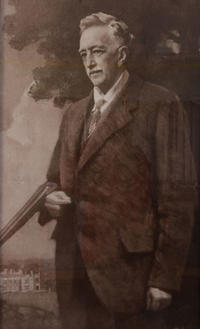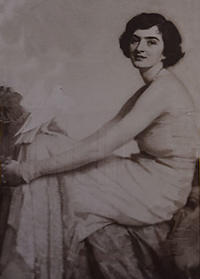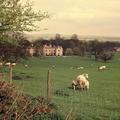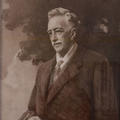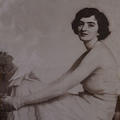The London Gazette 8/11/1917 announced that Raymond and his brother Walter had officially changed their surname to ffennell, their mother’s maiden name, derived from the Irish O’Fionnghail. It is likely the family found the name Schumacher was unpopular in England, as it had been in South Africa. It is interesting to note that around this time, a bill was passed in Parliament forbidding Germanic names to be changed to British names. Perhaps this is why we know that the King specifically granted permission for this change.
From 1916-18 Raymond was the Major in the Oxford University Officers Training Corps, attached to No.4 Officer Cadet Battalion. C.S. Lewis joined the battalion from 30/4/1917 until December 1917, so he was probably one of Raymond’s cadets. The trenches they trained in are still within Wytham Woods and are now regularly used for educational work.
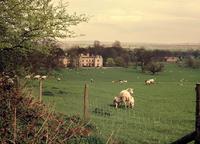
Wytham Abbey and Park
The ffennell family purchased the entire Wytham estate in 1920 from the Earl of Abingdon. As there were sitting-tenants the family did not live inside Wytham Abbey until 1926, instead living in the Chalet on the estate. Raymond ffennell bought the remains of Godstow Abbey in 1921 and sold it to the University with the proviso that the site should be looked after.
From 1916 onwards the family had created a sumptuous lifestyle using very expensive and wonderfully furnished large marquees, entertaining the cream of British and foreign society to ‘life in the country.’ This continued in the Abbey in the 1930s and there are reports of Ribbentrop being possibly being present. This is possible as he was the German Ambassador for part of that period. The German leadership thought the way to conquer England was via the aristocracy.
Of the marquees, Hazel is known to have said ‘the dining-room tent is up and when I entered it at the tiny door, I was literally amazed, a perfectly lovely room confronted me, yellow walls ,red carpet, refectory tables and a sideboard and other furniture.’
Raymond ffennell’s philosophy of helping less fortunate people continued in the Wytham area, just as he had done in Johannesburg. In 1926, the same year that the family moved into the Abbey, he visited West Oxford Infants School and asked the Head if her school would ‘like to come and play and have a picnic on the Wytham estate?’ Children from under-privileged backgrounds in East London initially went to the Hill End part of the estate. A little later, children from the very poor areas of Oxford visited, including St Thomas’s, St Ebbe’s and St. Giles schools. Many had not seen hardly any grass, let alone an estate of hundreds of acres.
It is possible that the ffennell family were influenced by Kurt Hahn, who was Head of the Schule Schloss Salem school before the Second World War. He was a Jewish educationalist, who eventually was told to leave Hitler’s Germany. Coming to the UK, he started Gordonston School and was one of the pioneers of the Outward Bound movement. He was running the same sort of activities as the ffennells in Germany during the interwar period.
Dr Ormerod, the Clinical Schools Medical Officer for the City of Oxford Medical Committee, was very impressed with the ‘ffennell experiment.’ The children and the Head teachers thought the weekly visits were brilliant, their teachers initially less so, as they often felt unable to answer questions such as ‘what is that flower?’
Another ffennell idea was a one hour compulsory sleep after lunch, teachers included. Wooden boards were carried up the hill at Hill End for this purpose. Several agricultural buildings were converted at Hill End, including the Barn, Green and Red Dragon buildings to help when the weather was inclement. Also wellington boots were loaned in the winter and Dutch sabots (clogs) in the summer.
Raymond was very keen that the Scouts and Girl Guides should visit the estate and throughout the 1930s the ‘Follies’ site was used, particularly by the Guides and sometimes the local Primary school. This second site was not far from Botley Lodge, accessible as the main A420 did not exist then, easy for the groups from West Oxford. The building had benches, trestle-tables, bowls and buckets. The Guides also used the ‘Guide Hut’ in Beanwood.
The number of schools and children increased year by year and by 1938 there were about twenty schools sending classes regularly to eleven classrooms. A number of the classrooms were on the main Wytham estate and a smaller amount at the Hill End camp. Over 1,000 children aged six to fourteen visited weekly from April to the end of September.
